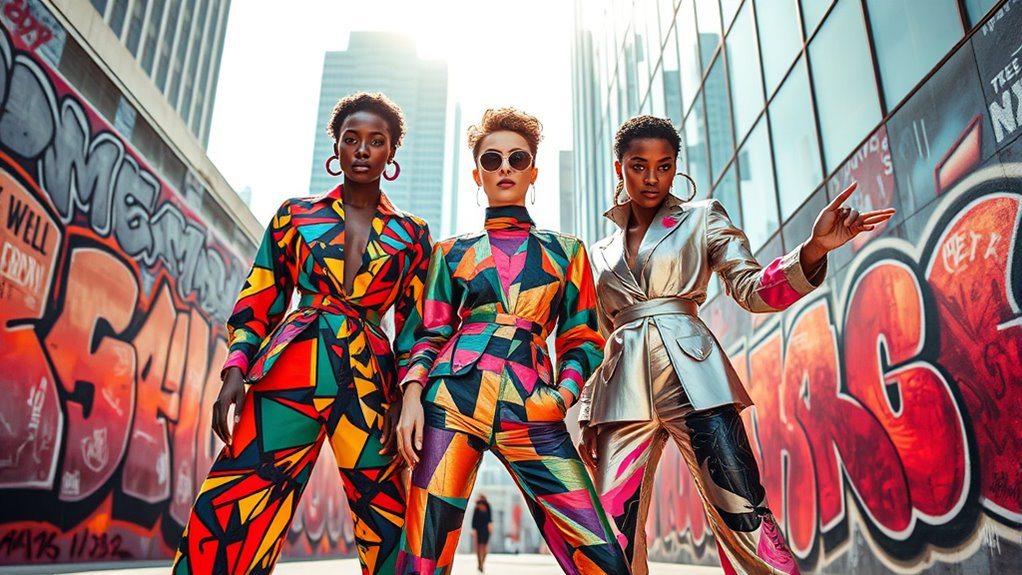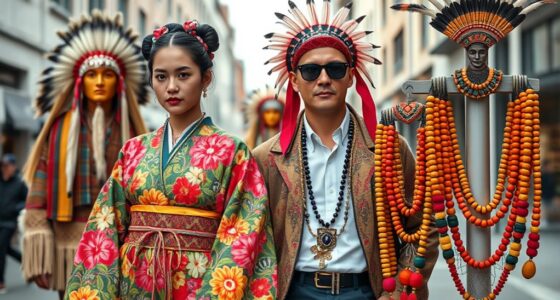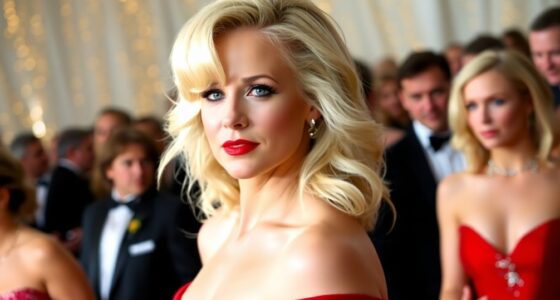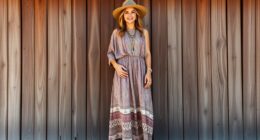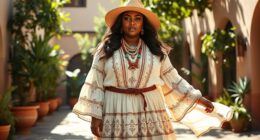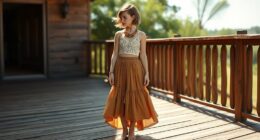The intersection of fashion and art has a rich history, blending creativity and innovation through collaborations with iconic designers, exhibitions, and technological advances. You see this in memorable runway shows, immersive displays, and art-inspired collections that challenge traditional boundaries. Brands now leverage these partnerships to boost their image and engage consumers with storytelling and exclusivity. If you continue exploring, you’ll discover how this dynamic fusion continues to evolve and shape the future of fashion and art.
Key Takeaways
- Fashion and art collaboration dates back to ancient civilizations, blending craftsmanship with cultural storytelling.
- Iconic events like the Met Gala showcase fashion as a form of immersive artistic expression.
- Pioneering designers like Alexander McQueen integrate technology and performance into fashion as art.
- Collaborations between artists and brands produce wearable sculptures that challenge traditional boundaries.
- Digital tools and virtual platforms enable innovative, interactive, and global creative partnerships in fashion and art.
Historical Roots of Fashion and Art Collaboration
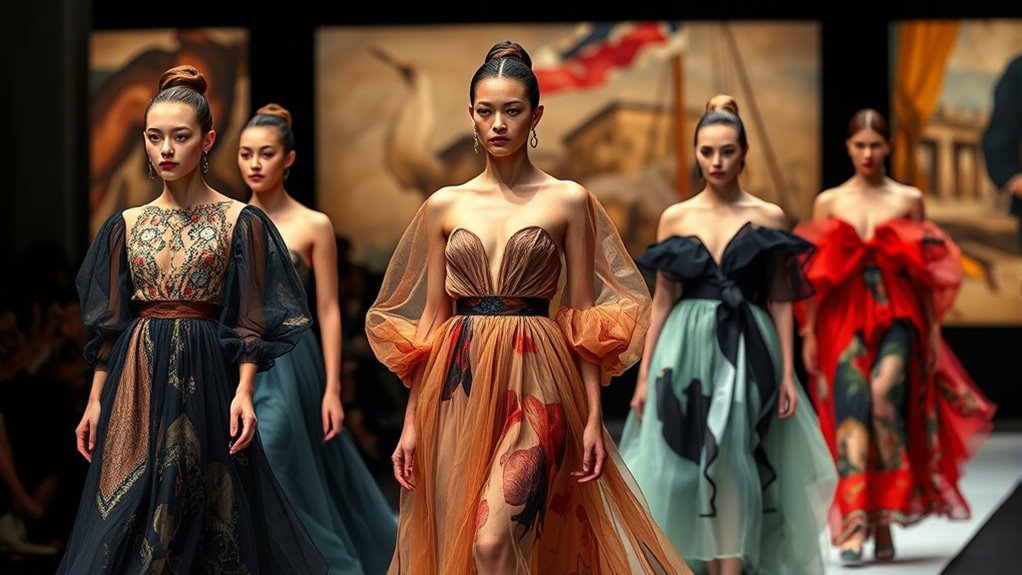
The collaboration between fashion and art has deep roots that trace back to ancient times, where clothing often reflected artistic expression and cultural identity. As you explore history, you’ll see how civilizations used textiles, dyes, and adornments to showcase status, beliefs, and creativity. In ancient Egypt, for instance, jewelry and garments featured intricate designs inspired by nature and spirituality. Similarly, the Renaissance period saw artists influencing fashion through the use of luxurious fabrics and elaborate embroidery, emphasizing wealth and artistic taste. During these eras, clothing became a canvas for cultural storytelling, merging craftsmanship with visual artistry. This early integration laid the foundation for modern collaborations, demonstrating how fashion continually draws inspiration from and contributes to the broader art world, with design techniques evolving alongside cultural shifts. Additionally, the influence of artistic movements has played a significant role in shaping fashion trends over the centuries, fostering a dynamic interplay between these creative domains. Modern fashion also incorporates innovative materials, pushing the boundaries of traditional design and expression. Furthermore, advancements in appliance technology, such as smart textiles and wearable devices, are opening new avenues for artistic expression in fashion, fostering interdisciplinary collaboration that merges technology with design.
Iconic Moments in Fashion-Driven Art Exhibitions

Iconic moments in fashion-driven art exhibitions showcase how style and creativity collide on grand stages. You’ve seen how events like the Met Gala blend high fashion with artistic expression, creating unforgettable visuals. From Alexander McQueen’s groundbreaking legacy to bold Fashion Week installations, these moments redefine what fashion art can achieve. Celebrating these intersections often involves visual and auditory cues, which enhance viewer engagement and deepen the artistic experience. These sensory elements are carefully curated to highlight the fusion of aesthetics and concept, making each exhibition a memorable multi-sensory experience. Additionally, incorporating elements like sound healing science can elevate the immersive quality of the displays, enriching the viewer’s emotional connection to the artwork. The use of glycolic acid products in skincare routines exemplifies how innovative formulations can influence personal and artistic expressions of beauty, inspiring collaborations across the creative industries. Notably, global variations in cultural influences, such as Halloween celebrations in different countries, demonstrate how diverse traditions can inspire innovative artistic expressions in fashion exhibitions.
Met Gala’s Artistic Flair
When the Met Gala transforms into a living canvas, it blurs the line between fashion and art, creating moments that captivate audiences worldwide. You witness designers and celebrities push creative boundaries, turning the event into a spectacular showcase of artistry. Elaborate costumes, inspired by art movements, historical themes, or avant-garde concepts, become immersive expressions rather than mere garments. For example, some attendees embrace theatrical costumes that evoke paintings or sculptures, making the event feel like an open-air museum. These iconic looks generate buzz far beyond the red carpet, inspiring artists and fashion enthusiasts alike. Every year, the Gala’s focus on artistic flair elevates fashion from clothing to a powerful form of visual storytelling, solidifying its reputation as a unique intersection of creative innovation. Additionally, the event’s emphasis on artistic expression encourages a dialogue between different creative disciplines, enriching the overall cultural impact. Incorporating elements of design aesthetics enhances the visual impact and helps bridge fashion with contemporary art, showcasing the importance of collaborative creativity in advancing innovative cultural narratives. Recognizing the influence of innovative material use further emphasizes how fashion as art can challenge traditional boundaries and inspire new artistic directions. Moreover, the integration of creative collaborations often leads to groundbreaking exhibits and installations that redefine the boundaries of both fashion and art.
Alexander McQueen’s Legacy
Alexander McQueen’s groundbreaking approach to fashion consistently pushed the boundaries between clothing and art, leaving a lasting legacy in the domain of fashion-driven exhibitions. His work transformed runway shows into immersive artistic experiences, often blurring the line between sculpture, performance, and design. You can explore some of his most iconic moments through exhibitions that showcase his visionary creativity:
- The haunting “Savage Beauty” exhibit at the Met Museum, highlighting his dark fairy-tale aesthetic.
- The theatrical presentation of “Plato’s Atlantis,” blending technology and fantasy.
- The intricate craftsmanship displayed in his feathered and embroidered pieces.
- The provocative “Highland Rape” collection, challenging societal norms.
- The use of dramatic staging and lighting that transformed runway shows into art installations.
- His innovative use of multimedia elements to enhance storytelling and create immersive environments that deepen the emotional impact of his collections. Incorporating fashion as art in his presentations, McQueen blurred traditional boundaries and redefined the possibilities of fashion exhibitions, inspiring future generations of designers and artists alike. His commitment to artistic innovation continually pushed the limits of creative expression within the fashion industry. Additionally, his collaborations with artists and performers further integrated diverse artistic disciplines, enriching the cultural significance of his work and demonstrating the importance of energetic alignment in creative collaborations.
Fashion Week Installations
Fashion week installations have become powerful platforms for transforming runway shows into immersive art experiences. You’re immersed in environments where fashion meets sculpture, technology, and performance. Designers use these installations to tell stories, evoke emotions, and challenge traditional presentation styles. Think of towering structures, dynamic lighting, and interactive elements that captivate audiences and create buzz beyond the runway. These moments become iconic when they push boundaries and redefine fashion’s role as art. For example, some installations incorporate multimedia, transforming the space into a living artwork. As a viewer, you’re not just observing; you’re participating in a multisensory experience. Incorporating technological innovation into these setups enhances engagement and offers new avenues for creative expression. These installations elevate fashion week from mere showcases to cultural events, leaving lasting impressions that influence future creative directions. Moreover, the integration of regional artistic influences can provide unique cultural contexts that enrich the overall experience and foster diverse interpretations. Additionally, embracing haute couture craftsmanship allows designers to demonstrate the artistry and meticulous detail that elevate collection presentations into true works of art.
Notable Designers and Artists Who Have Joined Forces
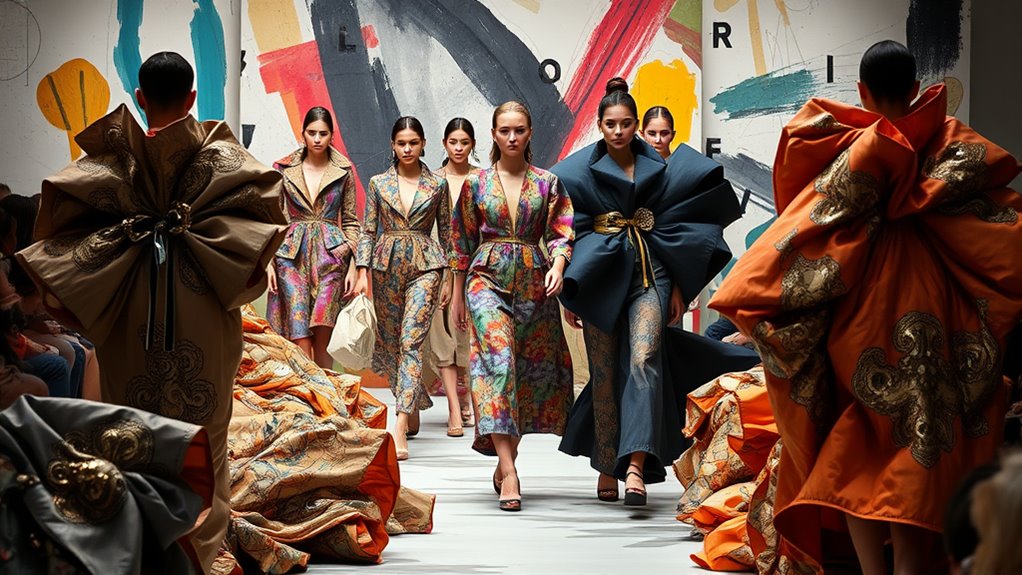
Throughout recent years, numerous renowned designers and artists have come together to create striking collaborations that blur the lines between fashion and art. These partnerships produce bold, innovative pieces that captivate audiences worldwide. You might see fashion houses teaming up with visual artists to craft wearable sculptures, or designers working with painters to incorporate signature brushstrokes into textiles. Such collaborations often lead to limited-edition collections that become highly sought after. Notable examples include:
- Jean-Michel Basquiat x Louis Vuitton
- Takashi Murakami x Louis Vuitton
- Alexander McQueen x Damien Hirst
- Yves Saint Laurent x Piet Mondrian
- Gucci x GucciGhost artist
These collaborations push creative boundaries, transforming garments into moving art displays. They showcase how blending talents sparks creative innovation, making fashion an immersive artistic experience. They also serve as a platform for artists and designers to experiment with new techniques and materials, broadening the scope of both fields. Additionally, these partnerships demonstrate how artistic innovation can drive cultural conversations and influence broader visual trends.
How Fashion Shows Are Becoming Artistic Performances
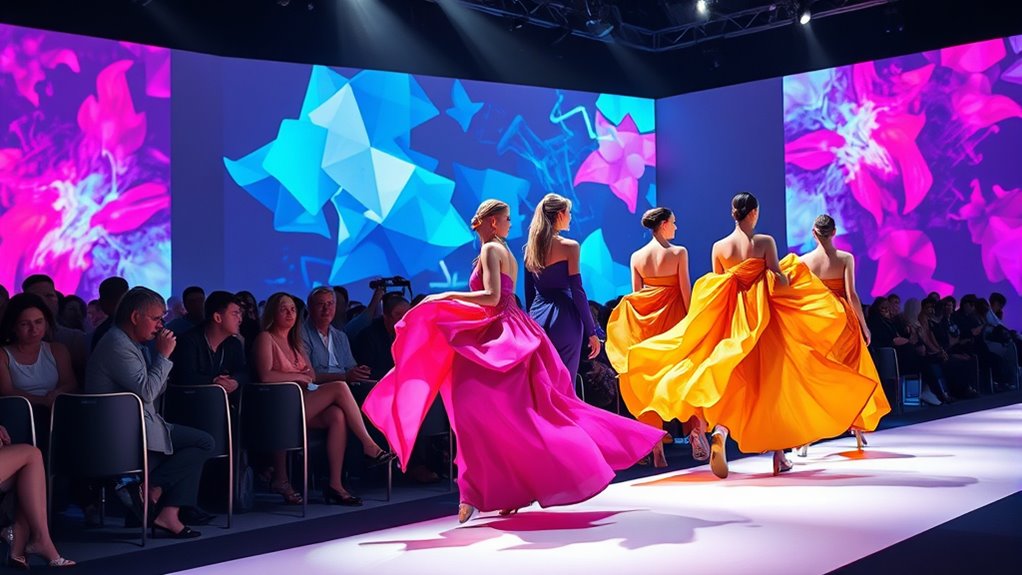
You’ll notice fashion shows now feel more like theatrical performances, with elaborate sets and choreography that captivate audiences. Designers are using runway presentations to tell stories and evoke emotions, turning simple displays into artful experiences. This blending of fashion and performance transforms shows into immersive artistic showcases.
Theatrical Runway Experiences
The runway has transformed into a stage where clothing becomes part of a larger performance. You’re immersed in a spectacle where designers combine fashion with theatrical elements to captivate your senses. Lights pulse in sync with music, creating an immersive atmosphere. Models move with choreographed precision, almost like dancers in a narrative. Set designs evoke emotions, from surreal landscapes to stark minimalism. Props and special effects enhance the story, blurring the line between fashion and performance art. You witness designers pushing boundaries by integrating dance, video projections, and live art into the show. Every element amplifies the clothing’s storytelling power, making the runway a dynamic canvas that engages and entertains. This evolution elevates fashion shows into immersive artistic experiences.
Artistic Storytelling Through Fashion
As fashion shows evolve into artistic performances, designers craft narratives that transcend mere clothing, turning each runway into a storytelling stage. You become immersed in a visual journey where garments symbolize themes, emotions, or cultural stories. Every detail—lighting, choreography, set design—works together to convey a message, engaging your senses and imagination. Instead of just observing fashion, you experience it as a living artwork, where models become performers and the runway transforms into a stage for storytelling. This approach blurs the lines between fashion and art, inviting you to interpret deeper meanings behind the designs. The show becomes a dynamic dialogue, inspiring you to see fashion as a powerful medium for artistic expression and narrative creation.
The Role of Technology in Merging Fashion and Art

Technology has revolutionized how fashion and art intersect, enabling creators to push boundaries and experiment with new forms of expression. You can now incorporate digital tools, 3D printing, and augmented reality into designs, transforming traditional concepts into immersive experiences. This fusion allows artists and designers to visualize ideas instantaneously, customize intricate details, and explore innovative materials. You might see virtual fashion shows where models walk digital runways or garments that change appearance with your movement. Interactive installations blend fashion with digital art, creating dynamic displays. Technology also facilitates global collaboration, connecting artists across borders in real-time. These advancements empower you to craft more daring, innovative pieces that challenge conventional boundaries and redefine how audiences engage with fashion and art.
Cultural Significance of Collaborative Fashion Pieces
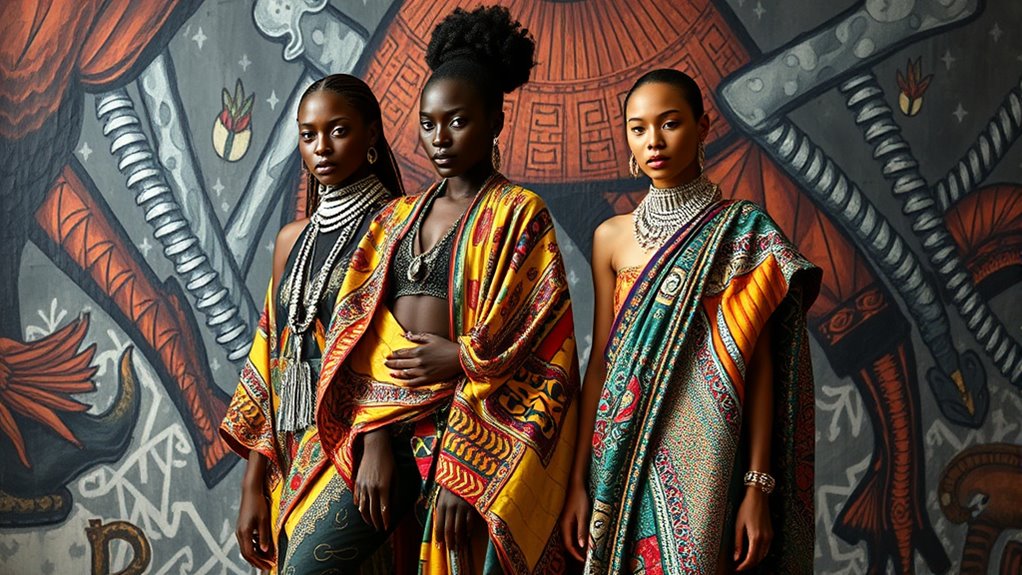
Collaborative fashion pieces often carry deep cultural significance because they blend diverse artistic traditions, social narratives, and collective identities. When you wear or showcase these creations, you’re not just making a style statement; you’re expressing a story rooted in history, culture, or community. These pieces can honor ancestral techniques, challenge societal norms, or celebrate shared values. They serve as visual dialogues that highlight cultural diversity and promote understanding across different groups. By working together across borders and disciplines, designers and artists create symbols that resonate beyond aesthetics, fostering pride and identity. Such collaborations often become cultural milestones, inspiring conversations about heritage, social issues, and collective memory. Ultimately, they deepen your appreciation for the rich, interconnected tapestry of human creativity.
Emerging Trends and Future Possibilities

Emerging trends in collaborative fashion are shaping a future where innovation and inclusivity take center stage. You’ll see designers partnering with tech firms to create smart textiles that adapt to your needs. Sustainability becomes more integral, with brands using recycled materials and eco-friendly processes. Digital fashion and virtual try-ons will become mainstream, making shopping more immersive and accessible. Collaborations will increasingly involve diverse voices, reflecting a broader range of cultures and identities. Additionally, you’ll notice a rise in community-driven projects that emphasize local artisans and sustainable practices. These trends push boundaries and redefine fashion as a platform for creative expression and social change.
- Integration of wearable technology for personalized experiences
- Focus on sustainable, eco-conscious materials
- Virtual and augmented reality shopping options
- Collaborations with diverse artists and communities
- Emphasis on inclusive sizing and representation
Impact on Consumer Perception and Market Dynamics
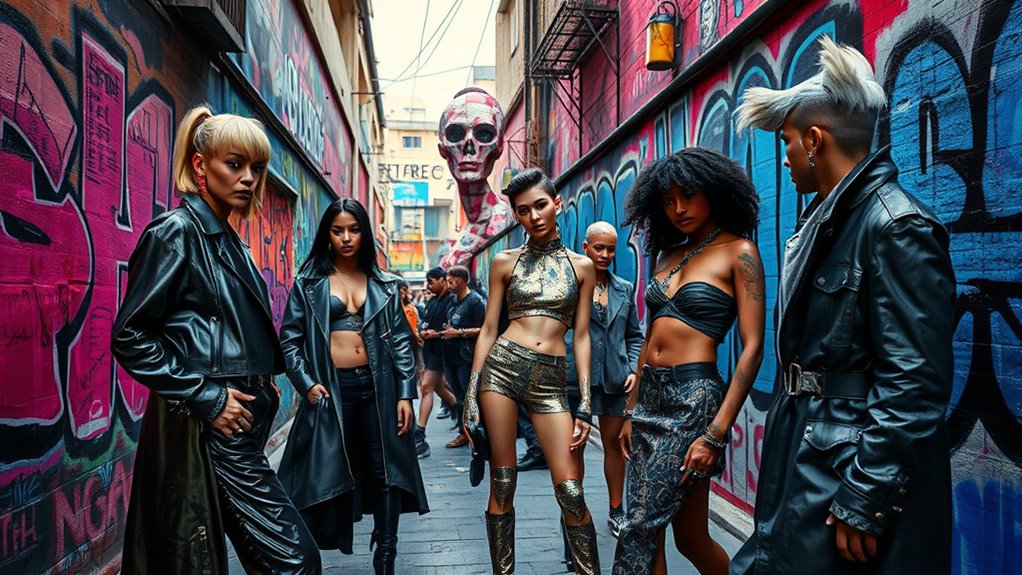
Innovations in fashion are reshaping how consumers perceive brands and their values. When brands collaborate with artists, it signals authenticity and creativity, making you see them as more innovative and culturally relevant. These partnerships often generate buzz, attracting new audiences and boosting brand loyalty. You’re more likely to view these brands as forward-thinking and socially conscious, which influences your purchasing decisions. Market dynamics shift as limited editions and exclusive collections create urgency, driving sales and elevating brand status. Consumers like you now expect more meaningful stories behind products, valuing originality over mass production. This fusion of art and fashion not only enhances brand perception but also fuels a competitive landscape where creativity becomes a key differentiator. Ultimately, it transforms how you engage with and evaluate brands in the marketplace.
Frequently Asked Questions
How Do Collaborations Influence Mainstream Fashion Trends?
Collaborations greatly shape mainstream fashion trends by blending diverse ideas and pushing boundaries. When you see designers teaming up with artists or brands, it often results in innovative, eye-catching collections that catch public attention. These partnerships introduce fresh styles and concepts that quickly spread through social media and retail. By embracing collaboration, you help drive trends forward, making fashion more dynamic and accessible to everyone.
What Are the Challenges in Merging Fashion and Fine Art?
You face challenges when merging fashion and fine art, balancing creativity with practicality, innovation with tradition, and expression with commercial appeal. These conflicts can cause tension, making it difficult to create seamless collaborations. You must navigate differing aesthetics, manage expectations, and maintain authenticity, all while pushing boundaries. Overcoming these challenges requires patience, open-mindedness, and a shared vision, ultimately forging a meaningful connection that enriches both worlds.
How Do Cultural Differences Shape Collaborative Projects?
Cultural differences greatly influence collaborative projects by shaping perspectives, values, and communication styles. You may find that varying cultural backgrounds lead to unique ideas, but also require extra effort to understand and respect each other’s traditions. Embracing these differences can foster innovation and richer creativity. You need to stay open-minded, adaptable, and empathetic, ensuring that diverse viewpoints enhance your project rather than hinder it.
What Role Do Social Media and Digital Platforms Play?
Did you know that over 4.7 billion people use social media worldwide? Social media and digital platforms are vital for your creative projects, allowing you to connect with diverse audiences and collaborators instantly. You can showcase your work, gather feedback, and inspire others across borders. These platforms amplify your voice, foster global community, and accelerate innovation, making collaboration easier and more dynamic than ever before.
How Do Collaborations Impact the Sustainability of Fashion Industries?
Collaborations can markedly boost the sustainability of fashion industries by encouraging innovative, eco-friendly designs and practices. You might find that working together helps share resources, reduce waste, and promote ethical production. When brands team up, they can develop sustainable materials and transparent supply chains, making eco-conscious choices more accessible. These partnerships foster a collective effort, ensuring the industry moves toward more responsible and lasting practices that benefit both the environment and consumers.
Conclusion
As you explore this vibrant crossroads of fashion and art, remember the spirit of Picasso’s daring innovations and Chanel’s timeless elegance. Together, they remind you that creativity knows no bounds, transforming runways into art galleries and sketches into cultural statements. Embrace the ongoing evolution, where technology and collaboration paint new horizons. In this fusion, you become part of a living masterpiece—forever shaping a world where beauty and expression intertwine like brushstrokes on a canvas.
